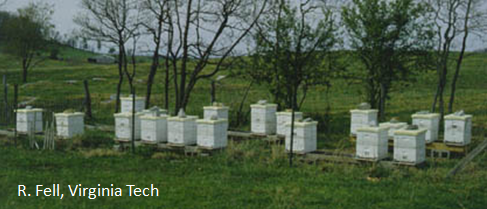With a barrage of perennial pests in the hive and a multitude of environmental stressors outside, beekeeping has come to require more intensive management to maintain healthy, strong colonies (see the resources at the end of this page for more information on managing honey bee health).
Manage Varroa Mites
Among in-hive pests, the Varroa mite is the major threat to honey bee health and survival. This mite weakens the entire bee colony as an external parasite of adults and brood, and as a vector (transmitter) of deadly viruses. Mite management relies on a limited number of cultural practices and a similarly limited number of chemical treatments (Varroacides) to which resistance is common. The most effective way to reduce/avoid Varroa resistance to existing and new products is to rotate, or alternate, the use of two of more EPA registered Varroacides. See the Resistance module for more information on understanding resistance and resistance management. New mite treatment options are being investigated by various institutions and companies. To find a product that’s virulent to mites but harmless to the bee is an enormous challenge. It is critical, therefore, that current Varroacides be used judiciously.
Follow Good Apiary Practices
In addition to making the best use of currently available mite management solutions, the most efficient way of managing bee health is through good apiary practices. These include hygienic measures, a sound knowledge of pathogen and bee life cycles, and providing good nutrition throughout the year. Honey bees have a limited capacity to metabolize chemical toxins, and some toxins can accumulate in beeswax combs. Therefore, it is a good idea to renew combs by replacing a few of them from each hive annually.
 Inspect your apiaries regularly so that any problem from pesticide damage can be detected. Dead bees can be swept away or eaten by scavengers quickly. If you have a pesticide poisoning incident report it (see Recognizing and Reporting Bee Kills). Click here for an example from Washington State Department of Agriculture. Without this report, the regulatory agencies have no information to indicate that anything is of concern about current pesticides or the manner in which they are being used or misused.
Inspect your apiaries regularly so that any problem from pesticide damage can be detected. Dead bees can be swept away or eaten by scavengers quickly. If you have a pesticide poisoning incident report it (see Recognizing and Reporting Bee Kills). Click here for an example from Washington State Department of Agriculture. Without this report, the regulatory agencies have no information to indicate that anything is of concern about current pesticides or the manner in which they are being used or misused.
Follow Local Regulations/Programs
Check for specific local ordinances pertaining to pollinators, especially beehive locations or designated preserves (if applicable). In many farming areas, state departments of agriculture can provide information about pollinator protection. Some regions require that commercial beehive operations register the location where hives are being kept. There may be restrictions concerning establishment of apiaries, as well. Many states have regulations (for example, the Iowa “Pesticide/Bee Rule”) intended to reduce the hazard of insecticide applications to bees.
It is permissible to maintain beehives in fields that are designated for the Conservation Reserve Program (CRP). This acreage may be considered a safe haven for hives wherein natural sources of pollen and nectar may sustain colonies throughout the year. Read the memo from the USDA granting permission to place hives on CRP acreage.
For More Information on Beekeeping and Honey Bee Health:
1. IPM Elements for Honey Bees in the Mid-Atlantic States. Beekeeping Guide/Checklist for beekeepers in DE, MD, NJ, NC, PA, SC, VA, and WV. For in-depth coverage of honey bee pests and control strategies see Pest Management Strategic Plan for Honey Bees in the Mid-Atlantic States.
2. Bee Health. eXtension.org Community of Practice.
Compiled by Wayne Buhler, PhD.

Topics Included in this Module
- Introduction to Pollinator Protection
- Honey Bees and Beekeeping
- Bees in Peril
- Pesticide Toxicity to Bees
- Read and Follow the Label
- Pesticide Applicator BMPs
- Seed Treatment Concerns
- Beekeeper BMPs
- Cooperate and Communicate
- Recognizing and Reporting Bee Kills
- Resources and Suggested Reading
- Presentations